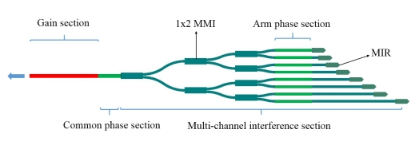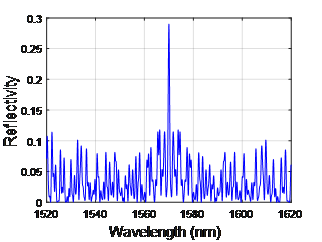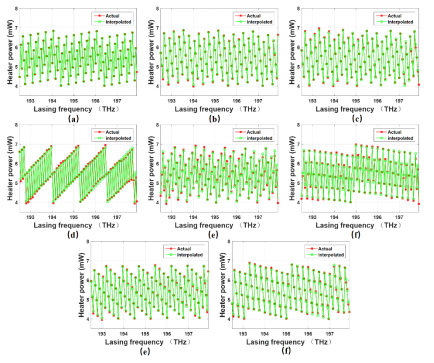MCI Tunable Laser

Fig. 1. Schematic drawing of the multi-channel interference (MCI) laser.
Multi-channel interference (MCI) laser is a monolithic InP based widely tunable semiconductor laser, as shown in Fig. 1. The MCI laser is electronically/thermally tuned, which can address any wavelength in a range of more than 40 nm. Mode selection of the MCI laser is based on constructive interference of eight arms with unequal length difference [1]. By injecting currents into or heating the eight arm phase sections, we can make the eight arms in phase at any desired wavelength so as to generate a narrow strong reflection peak at the desired wavelength, as shown in Fig. 2. Therefore, the MCI laser can be fabricated easily with standard photolithography, which can reduce the fabrication cost. Besides, due to the independent arm phase sections, the MCI laser is insensible to the initial phases of the eight arms, which makes the MCI laser have a large fabrication tolerance. The MCI laser has been demonstrated to have a tuning range of more than 53.6 nm and side mode suppression ratios (SMSRs) larger than 40 dB across the tuning range [2]. By adjusting the bandgap of the MQWs, tuning range of the MCI laser can cover the whole C band or L band. Semiconductor optical amplifier (SOA) has also been successfully integrated with the MCI laser by a two port multi-mode interference reflector (MIR) [3]. The two port MIR can be fabricated simultaneously with the deeply-etched waveguides of the MCI laser without increasing the fabrication complexity. The SOA can be used to control the output power and compensate the power variation between different channels. When reverse biased, the SOA acts as a shutter so as to enable dark tuning between channels.

Fig. 2. Calculated reflection spectrum from the right side of the gain section with a main reflection peak at wavelength 1550 nm.
To meet the requirement of high output power coupled into fiber, an integrated SOA is usually used to boost the output powers of tunable semiconductor lasers. SOA were successfully integrated with the MCI laser through a two-port MIR. The two port MIR can be fabricated simultaneously with the deeply-etched waveguides of the MCI laser without increasing the fabrication complexity. The SOA can be used to control the output power and compensate the power variation between different channels. When reverse biased, the SOA acts as a shutter so as to enable dark tuning between channels. A microscope image of a fabricated MCI laser with integrated SOA is shown in Fig. 3.

Fig. 3. Microscope image of a fabricated MCI laser with integrated SOA.
A specified characterization scheme has been established to characterize the MCI laser quickly and accurately. The correlation between the lasing frequencies and the tuning powers of the CP and AP phase sections is shown in Fig. 4.

Fig. 4. Tuning powers of the CP (a) and AP (b-f) phase sections vs lasing frequencies.
Reference:
[1] Chen Q., Lu Q., et al. Theory and simulation of multi-channel interference (MCI) widely tunable lasers[J]. Optics Express, 2015.
[2] Chen Q., Jiang C., et al. 1 × 8 MMI based multi-channel interference laser integrated with SOA through a 2-port multimode interference reflector[J]. Optics Express, 2018.
[3] Chen Q. , Jiang C. , Wang K. , et al. Narrow-linewidth thermally tuned multi-channel interference widely tunable semiconductor laser with thermal tuning power below 50 mW[J]. Photonics Research.





